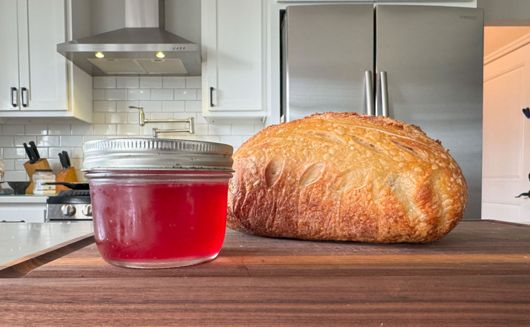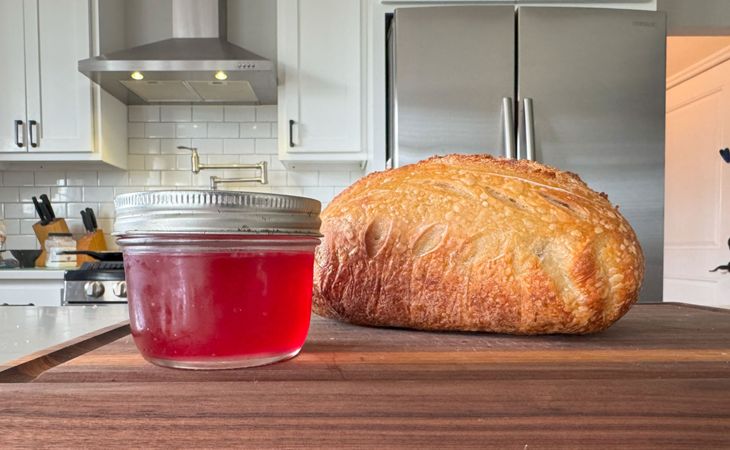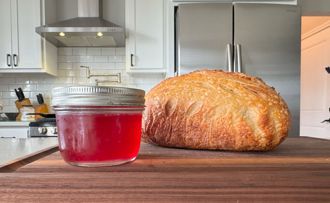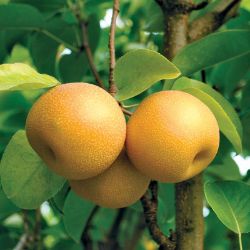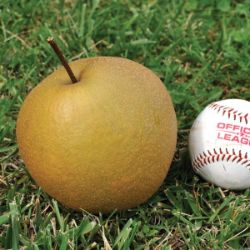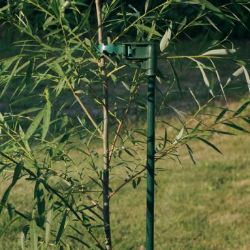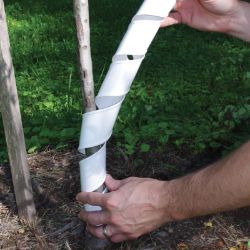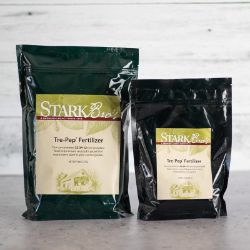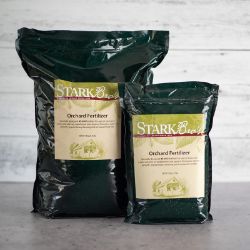Pest & Disease Control for Pear Trees
Every fruit tree has the future potential for disease and insect damage. Factors such as location and weather will play a part in which issues your tree encounters. Disease-resistant trees are the best option for easy care; and for all trees, proper maintenance (such as watering, fertilizing, pruning, spraying, weeding, and fall cleanup) can help keep most insects and diseases at bay.
NOTE: This is part 7 in a series of 11 articles. For a complete background on how to grow pear trees, we recommend starting from the beginning.
Crown Gall
Trees appear stunted and slow growing; leaves may be reduced in size, little or no fruit. If tree is dead, inspect roots for hard, woody ‘tumors’. Note: many things can cause stunted trees.
Control
- Consult County Extension Agent
Scale
Usually on bark of young twigs and branches, encrusted with small (1/16”) hard, circular, scaly raised bumps with yellow centers, may also be on fruit. Sap feeding weakens the tree.
Natural Control
- Monterey Fruit Tree Spray Plus
- Monterey Horticultural Oil
- Safer® Brand Insect Killing Soap
Chemical Control
- GardenTech® Sevin® Concentrate Bug Killer
Tarnished Plant Bug
Yellow-brown winged insect may have black spot or red stripes. Injects toxins into the buds and shoots causing ‘dwarfed’ shoots and sunken areas (cat facing) on fruit.
Natural Control
- Monterey Fruit Tree Spray Plus
- Safer® Brand Insect Killing Soap
Chemical Control
- GardenTech® Sevin® Concentrate Bug Killer
Leafroller
Pale yellow or ‘dirty’ green worms. Leaves are rolled and webbed together where insects feed. Eventually becomes ‘skeletonized’.
Natural Control
- Monterey Horticultural Oil
- Hi-Yield® Vegetable & Ornamental Insect Control
- Natural Guard® Caterpillar Killer Spray w/BT
Chemical Control
- GardenTech® Sevin® Concentrate Bug Killer
Scab
Spots on young leaves are velvety and olive green turns black; leaves wither, curl and drop. Fruit also has spots, is deformed, knotty, cracked and drops.
Natural Control
- Monterey Fruit Tree Spray Plus
- Monterey Liquid Copper Fungicide
Leaf Spots
Fabraea Leaf Spot
- Most often occurs in areas with warm, wet, humid summers. Young leaves develop red to purple pinpoint spots on top or bottom. Spots enlarge, turn dark brown, may coalesce, and could drop. Usually worse on lower half of tree, fruit may also develop spots and crack.
Septoria Leaf Spot
- Infection mainly on foliage and on the upper surface of the leaf. Spots are grayish-white with purplish margins, which are sharply defined at maturity. Centers have scattered black dots. Dead tissue may fall out giving a shot-hole appearance. When infection is serious, leaves fall in late summer.
Natural Control
- Remove all infested leaves and debris and bury or burn them.
Other Control Options
- Consult County Extension Agent
Pear Psylla
Adult is transparent, yellow-brown 1/8” jumping winged insect. Immature has no wings. Usually on underside of leaves and leaf stem. Sap feeding weakens the tree. Sticky residues become growth media for Sooty Mold.
Natural Control
- Monterey Fruit Tree Spray Plus
- Monterey Horticultural Oil
- Safer® Brand Insect Killing Soap
Chemical Control
- GardenTech® Sevin® Concentrate Bug Killer
Aphids
They are the size of a pinhead and vary in color depending on the species. Clusters on stems and under leaves, sucking plant juices. Leaves then curl, thicken, yellow and die. Produce large amounts of a liquid waste called “honeydew”. Aphid sticky residue becomes a growth media for sooty mold. Dormant Oil will kill eggs, use next dormant season, also during ½” green kills newly hatched except Rosy Apple aphid.
Natural Control
- Safer® Brand Insect Killing Soap
- Monterey Fruit Tree Spray Plus
Chemical Control
- GardenTech® Sevin® Concentrate Bug Killer
Green Fruitworm
Bluish-gray moth. Larvae are 1” long, usually green or brown with white spots and body stripes. Feeds on young leaves and young fruits. Disfigures the fruit.
Chemical Control
- GardenTech® Sevin® Concentrate Bug Killer
Fireblight
Blossoms and fruit spurs withered; looks as if ‘scorched’ by fire, with dark brown or blackened leaves; tips of leaves curl under. Twigs and branches die. Cut back infested branches 4” below disease. Disinfect shears between cuts with 1 part bleach and 10-part water solution. Dispose of pruning. Fall cleanup is essential, including all mummified fruits and leaves hanging on the tree. The above steps need to be done exactly as stated.
Natural Control
- Prune out infected area.
Chemical Control
- Ferti-lome® Fire Blight Spray (not on west coast)
Plum Curculio
Adult is brownish-gray 1/5” long, hard-shelled beetle with long snout and 4 humps on back. Cuts a crescent shaped hole under fruit skins and lays eggs. Worms hatch and tunnel into fruit. Premature dropping of fruit can occur.
Chemical Control
- GardenTech® Sevin® Concentrate Bug Killer
Tent Caterpillar
Hairy caterpillars that enclose large areas in webbing and feed on enclosed leaves. Remove web with rake and burn. Caterpillars are pulled out with webs.
Natural Control
- Safer® Brand Insect Killing Soap
- Monterey Fruit Tree Spray Plus
- Natural Guard® Caterpillar Killer Spray w/BT
- Remove web with rake and burn.
Chemical Control
- GardenTech® Sevin® Concentrate Bug Killer
Codling Moth
Adult is moth, gray with brown patches on wings. Worms about 1” long. Fruits have holes from side to core.
Natural Control
- Hi-Yield® Vegetable & Ornamental Insect Control
- Traps
Chemical Control
- GardenTech® Sevin® Concentrate Bug Killer
Mites
Pinpoint size, many different colors. Found on undersides of leaves. Sap feeding causes bronzing of leaves. Severe infestations have some silken webbing.
Natural Control
- Monterey Fruit Tree Spray Plus
- Monterey Horticultural Oil
- Safer® Brand Insect Killing Soap
Chemical Control
- GardenTech® Sevin® Concentrate Bug Killer
Black Rot, Frog Eye Leaf Spot
Leaf symptoms begin 1-3 weeks after petal fall as small purple flecks. These enlarge into lesions with purple margins and tan to brown centers, resembling ‘frog eyes’. When heavily infected, leaves may fall. Fruit infection can begin as soon as bud scales loose and appear on young fruit as red flecks that develop into purple pimples. These do not grow much until fruit begins to mature. Spots on mature fruit are irregular, black with red halo. As they enlarge a series of concentric rings form alternating from black to brown. Lesions stay firm and are not sunken. Fruit mummifies and stays attached to the tree. Rot in seed cavity or around core may be caused by early infections, but these usually fall within a month after petal fall with no surface symptoms. May be reddish-brown sunken cankers on limbs.
Control
- Consult County Extension Agent
Japanese Beetle
Adult is a metallic green beetle. It skeletonizes leaves. Larvae are a grub, which feeds on turf roots. Check turf product labels for timing of control of grubs. This is more of a problem east of the Mississippi river.
Natural Control
- Traps
Chemical Control
- GardenTech® Sevin® Concentrate Bug Killer
Leafhopper
Various colors and similar to aphids this small, active, slender-winged insects are usually found on the underside of leaves. Retard growth, leaves become whitened, stippled or mottled. Tips may wither and die. This insect carries virus of certain very harmful plant diseases.
Natural Control
- Safer® Brand Insect Killing Soap
- Monterey Fruit Tree Spray Plus
Chemical Control
- GardenTech® Sevin® Concentrate Bug Killer
Rose Chafer
Beetle has ½” long, tan wings with reddish-brown edges. Long, thin hairy legs. Skeletonizes leaves and flowers. Present in large quantities in June and July. Worst on sandy sites near grassy areas.
Chemical Control
- GardenTech® Sevin® Concentrate Bug Killer
Gypsy Moth
Egg masses are about 1” long, hairy and buff colored, found attached to buildings, walls, fences and trees. Caterpillars hatch out in April and feed on fruit and forest trees (including conifers). Cocoons are formed in late July and the moth emerges about a month later. Males are dark brown, less than an inch long. Females are buff-colored and heavy.
Natural Control
- Natural Guard® Caterpillar Killer Spray w/BT
Thrips
Tiny, slender, fringed wing insects ranging from 1/25 to 1/8” long. Nymphs are pale yellow and highly active and adults are usually black or yellow-brown, but may have red, black or white markings. Feed on large variety of plants by puncturing them and sucking up the contents.
Natural Control
- Safer® Brand Insect Killing Soap
- Monterey Fruit Tree Spray Plus
Leaf and Stem Blight
Leaves are soft and water soaked. Brown and black irregular blotches appear and spread to cover the leaves. Areas on the stems turn black, soft and sunken.
Natural Control
- Monterey Liquid Copper Fungicide

